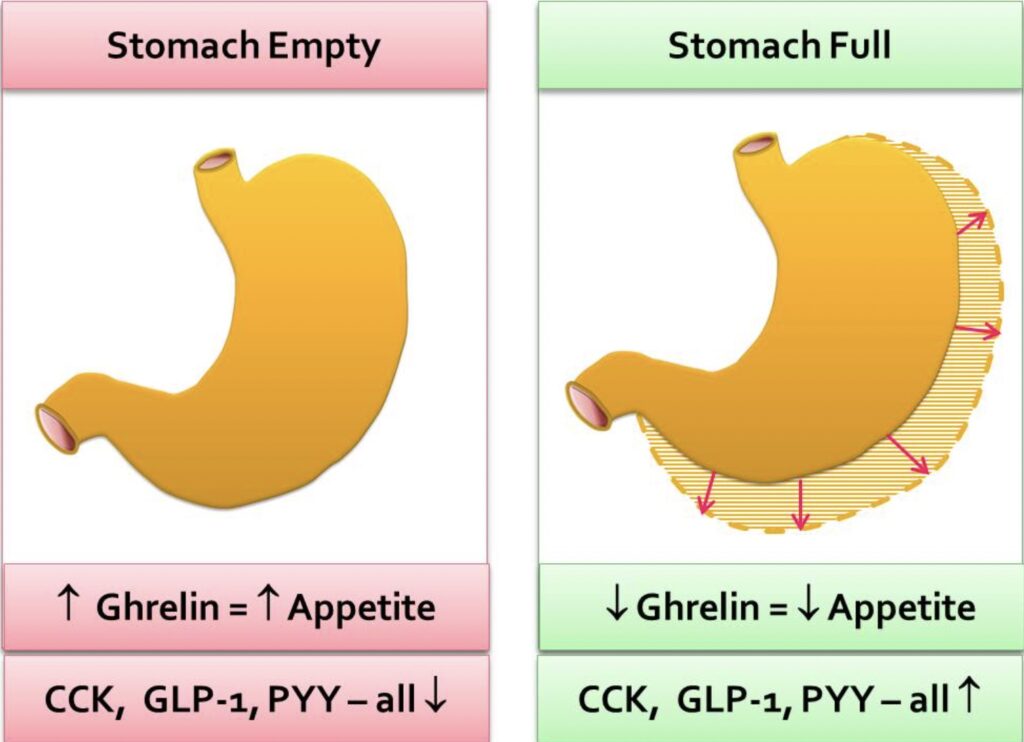Have Your Fill: How to Eat Just the Right Amount for You
- At December 10, 2010
- By Katherine
- In Articles
 0
0

It’s not rocket science: Eat fewer calories than you burn and you’ll lose weight.
But somehow it seems almost impossible to do. How could something so simple be so hard? The dilemma we all face is how to eat less without feeling hungy and deprived. The solution, while not as important for short-term weight loss, is essential to weight maintenance. Any diet that keeps us hungry is doomed to fail over the long haul.
For decades, scientists have been digging for clues about what influences the decisions to start and stop eating. They have found that our bodies have a complex physiological signaling system that tells us when we’re hungry and when we’ve had enough. When you’re eating, nerves in the stomach wall detect your stomach is stretching. They send satiation messages to the brain and you start to feel full. When food is sensed in the intestines, several substances are activated there as well, including nerve regulators and hormones such as cholecystokinin (CCK).
The physiological sensation of hunger has been more difficult for researchers to pin down. Emerging research points to ghrelin (pronounced GRELL-in), a hormone sent into your bloodstream by the stomach when it is empty.
The level of ghrelin “goes up before meals — making you hungry — while the other satiating hormones go up after eating [with ghrelin going down], causing you to stop,” says David E. Cummings, associate professor of medicine at the University of Washington and the Veterans Affairs Puget Sound Health Care System. “With these two systems, you have physiological control over pre-meal hunger and post-meal satiety.”
Of course, we’re not automatons governed strictly by physiology. The decision to eat is also governed by things we can control.
“In humans, ghrelin may not be the only driver. Initiation of meals is a complex process that deals with social cues, smells, sights and more,” says Phil Smith, co-director of the Office of Obesity Research at the National Institute of Diabetes & Digestive & Kidney Diseases.
Evidence suggests that many factors are related to your satisfaction with a meal and ultimately, your ability to lose and maintain weight:
Portion Size
In a series of widely known experiments over the past five years, researchers found that the amount of food you are served will affect how full you feel and how much you eat. In the studies, people were given varying amounts of macaroni and cheese, submarine sandwiches and bags of popcorn or chips. In each case, when they were served smaller portions, they ate those portions and felt satisfied. But when they were given larger portions, without realizing it, the subjects (including children, in other similar studies) ate significantly more — sometimes 50 percent more.
This effect persisted. Over two days, when portions were 50 percent larger at each meal, subjects ate 16 percent more (328 extra calories in women and 522 extra calories in men per day). When the portionswere 100 percent larger, subjects ate 26 percent more (531 extra calories in women and 806 extra calories in men).
Those extra calories, added daily over the course of a year, would pack 50 pounds more on women and 80 pounds more on men.
“This is a case where physiological satiety cues are overridden by environmental cues such as large portions and the easy availability of food,” says Barbara Rolls, co-author of the studies and a professor of nutritional sciences at Pennsylvania State University in University Park. “When served larger portions, people adjust their level of satiety to accommodate greater calorie intakes.”
Fortunately, studies also have found that the reverse is true. When good-tasting, lower-calorie foods or portion-controlled meals are available, people will eat those and feel just as satisfied. In fact, studies of successful weight loss maintainers find they easily adjust to smaller, more appropriate portions of higher-calorie foods.
An interesting study showed that preschool-age girls who regularly overeat can be taught how to change their behavior by learning to pay attention to their natural hunger and satiety signals.
Water and Air Content
Barbara Rolls, Professor and Director of the Laboratory for the Study of Human Ingestive Behavior, and colleagues, found that as long as the volume of the food is high, people can feel full with fewer calories.
In one study, participants who drank milkshakes blended with more air, compared with the same shakes containing less air, ate 12 percent less at the next meal without realizing it.
In another experiment testing this phenomenon, Rolls served subjects one of three meals. They were served either Chicken & Rice Casserole, Chicken & Rice Casserole with a glass of water, or Chicken & Rice Casserole with water added, making it into a soup. Only in the condition where the subjects ate the soup, did thy feel full, while eating 25% fewer calories.
Next, the researchers served salads of various sizes and calorie levels before a main course to determine the effect on the calorie intake of the whole meal. Participants consumed the fewest overall calories — 100 calories fewer — when they were served the largest salad before a meal.
How Does This Work?
Researchers surmise that a large food volume caused by water or air, even without added calories, influences satiety in at least three ways:
-It causes stomach stretching and slows stomach emptying, stimulating the nerves and hormones that tell you when it’s time to put down the fork,
-Seeing a large volume of food can increase your ability to feel satisfied by it, and
-Finally, the larger a meal is and the longer a meal goes on, studies show, your satisfaction declines and you lose interest in completing it
Pump It Up
Get back to basics and listen to your body signals. Start by rating your hunger on a five-point scale:
0 = ravenous
1 = hungry
2 = could eat, could wait
3 = satisfied, no longer hungry
4 = uncomfortably full
5 = stuffed
Give yourself a rating before you start eating and another rating when you finish. You should eat when you’re hungry (1) and stop when you’re no longer hungry (3)*
To feel full with fewer calories, try these tips from Barbara Rolls, author of “Volumetrics,” whose research shows that people have greater success with weight loss when they eat larger servings of foods that have a high water content, such as cooked grains, vegetables, fruits, soups and stews:
• To lower the calories and increase the portion size of a favorite recipe, pump up the volume by adding vegetables as often as you can. This way, you can eat your usual portion for fewer calories
• Choose fresh fruits over dried fruits or juices. For 100 calories, you could eat 1/4 cup of raisins or two cups of grapes. (You’re more likely to fill up on the grapes.)
• Whip air into your yogurt and fruit snack by putting it into a blender and turning it into a smoothie.
• Try air-popped popcorn (3 cups is only 90 calories) or flaky or puffed cereals.
• Start lunch or dinner with a bowl of broth-based vegetable soup or a big vegetable salad with low-calorie dressing.
• Turn main courses into soups or salads by adding water or vegetables.
— Katherine Tallmadge
© 2004 The Washington Post Company











